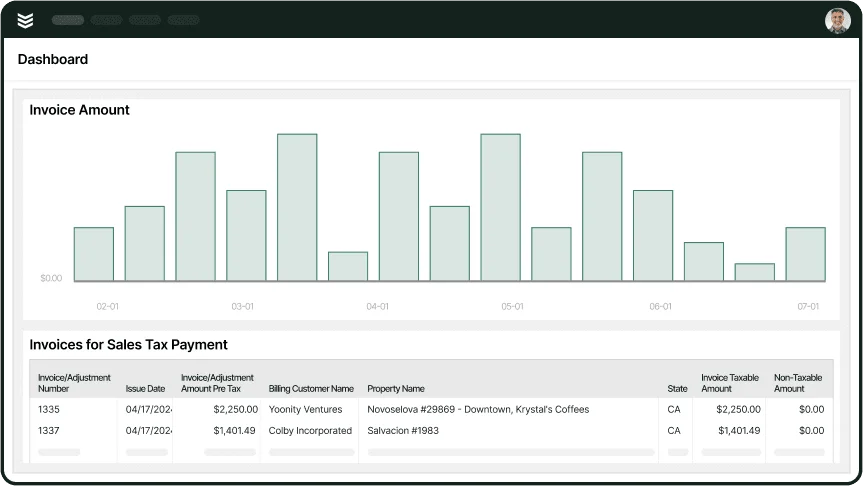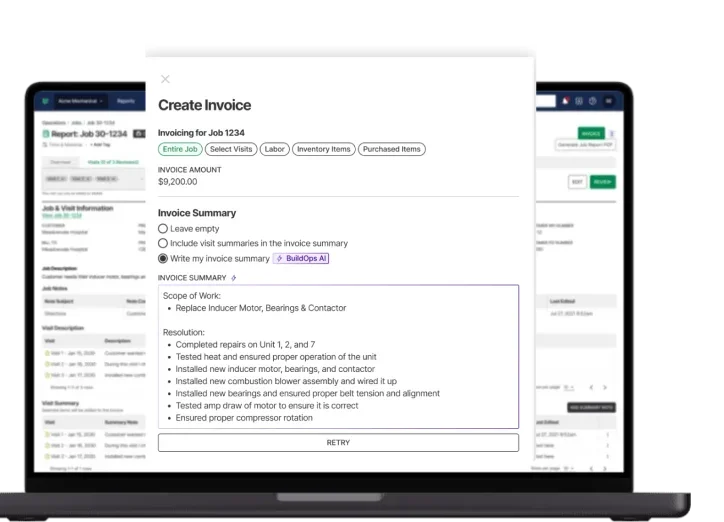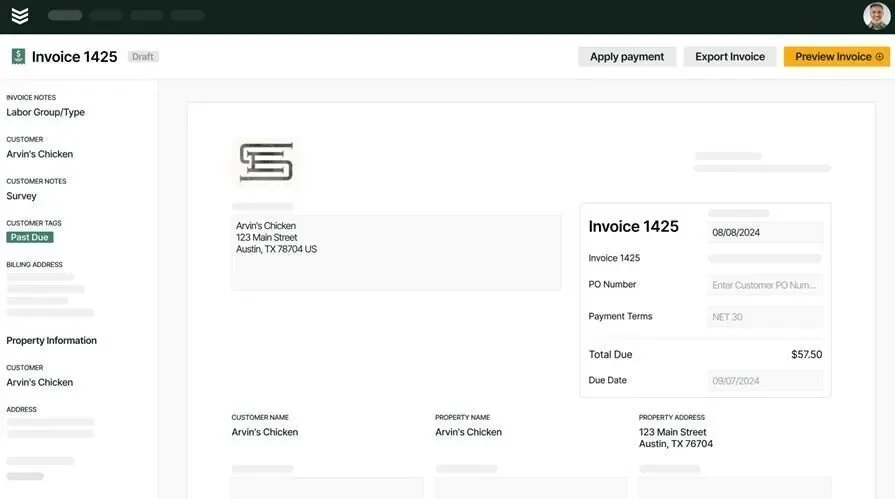Work orders and invoices are usually treated as separate documents for good reason. One gives the crew a breakdown of what needs to be done. The other tells the customer what it cost. But in the electrical industry—especially when jobs move fast—combining them can save time and cut down on confusion. An electrical work order invoice does both: it lays out the scope of the job and locks in the final bill. It keeps field teams and office staff aligned, reduces paperwork, and helps electrical contractors stay organized from start to payment.
This guide breaks down how it works, why it matters in the electrical industry, and what you need to include to protect your crew and your bottom line.
- What is an electrical work order invoice?
- 7 benefits of using electrical work order invoices
- What to include in a work order invoice for electricians
- 8 best electrical work order invoice templates
If you’re running electrical jobs—residential, commercial, or industrial—you’ve likely used work orders and invoices separately. But combining them can save time, reduce errors, and simplify your process. Let’s start with the basics.
What is an electrical work order invoice?
An electrical work order invoice is a single document that combines two essentials: a work order outlining the job and an invoice listing the final cost. While these are typically handled separately, more contractors are using a combined format to simplify job documentation and speed up billing.
It gives the field crew a defined scope of work, helps the office track labor and materials, and ensures the customer gets a detailed, itemized bill—all in one place. For electrical service work like panel installs, system repairs, or inspections, it’s a practical way to stay organized, avoid miscommunication, and get paid faster.
Deep Dive
You can see how this looks in practice with these electrical contractor invoice examples, which show how job details and pricing are presented clearly on a single form.
Common electrical services included on work order invoice
Most electrical work order invoices cover a mix of installation, maintenance, and repair tasks. These services give the field crew clear direction and provide the customer with a detailed breakdown of what’s being done on-site.
- Panel Installation: Adding or upgrading electrical panels to support new circuits or increased load in residential or commercial spaces.
- Lighting Maintenance: Checking, cleaning, and replacing lighting components in offices, warehouses, and multi-unit buildings.
- Wiring Repairs: Fixing damaged, frayed, or outdated wiring that poses a safety risk or causes power issues.
- Outlet and Switch Installation: Installing new outlets, GFCIs, or smart switches during renovations or system upgrades.
- Breaker Replacement: Swapping out faulty or overloaded breakers to restore safe operation and meet code compliance.
These are the day-to-day jobs that show up on nearly every invoice. When they’re clearly listed and easy to understand, you avoid mix-ups, speed up approvals, and stay ahead of callbacks. Let’s get into the real advantages of using these combined work order invoices.
7 benefits of using electrical work order invoices
Electrical contractors don’t have time for duplicate paperwork, missed charges, or unclear job records. A combined work order invoice simplifies your process by merging two essential documents—making it easier to manage jobs, bill accurately, and get paid faster. Here’s why that matters on real job sites:
1. Fewer communication breakdowns between the field and office
When job details live in separate documents, things get missed—materials used in the field don’t make it onto the invoice, or office staff misinterpret what was actually completed. With a combined work order invoice, everything from the initial scope to the final cost is in one place. Techs know what’s expected, and the office doesn’t have to track them down for updates. This kind of clarity keeps jobs on pace and limits confusion for everyone involved.
2. Billing happens quicker, with fewer delays
Most invoicing delays come from trying to rebuild the job after the fact—figuring out hours worked, materials used, and services performed. A combined document eliminates that scramble. As soon as the job is done, the billing is ready. That means faster turnaround on invoices and fewer hold-ups in getting paid. For electrical contractors who rely on steady cash flow to keep operations moving, these saved hours can make a major difference. If you want to see how others in the trade structure their billing process, our article about electrical contractor invoicing covers a similar topic but outlines a few practical models specifically focused on learning how to get paid faster.
3. Reduces the risk of missed jobs or incomplete documentation
When jobs are tracked in multiple places, it’s easy for things to slip through—especially during high-volume weeks or when team members are stretched thin. Combining work and billing records means each job has one paper trail, from the initial call to the final invoice. This structure helps prevent unbilled work, duplicate tasks, or missed steps in the field. For shops looking to grow, that kind of operational discipline is key to scaling without chaos.
4. Improves customer trust by creating clearer records
Clients don’t want vague invoices. They want to know exactly what they’re paying for. A detailed work order invoice lays out the full picture—what was installed, what was fixed, how long it took, and what it cost. When customers see a clean, itemized summary, it shows you run a professional operation. It also cuts down on disputes or callbacks. Having a reliable invoicing process that reflects the actual work done is one of the simplest ways to strengthen client relationships.
5. Streamlines scheduling and job tracking
With job information captured in a single document, it’s easier to prioritize what’s ready, what’s in progress, and what still needs attention. Combined work order invoices make it simpler to assign follow-up work, spot overdue tasks, or schedule based on real-time job status. That’s especially helpful for shops handling multiple crews across different job sites. If refining your scheduling system is a priority, learning about the best electrical contractor scheduling apps helps you navigate how it breaks down what to look for in tools that support this kind of workflow.
6. Makes reporting and auditing faster and more accurate
Pulling data at the end of the month—or even for a mid-week review—can turn into a time sink when you’re bouncing between systems or trying to match disconnected notes. A unified document structure means all job, labor, and billing details are linked. That makes it easier to generate reports, track crew productivity, or flag unbilled time. Whether you’re reconciling payroll or prepping for a client meeting, that kind of visibility cuts the admin load significantly.
7. Helps maintain a cleaner, more useful CRM record
When every job is tied to a customer record with full work and invoice details, your CRM becomes a real business tool—not just a contact list. You can track service history, spot repeat issues, and quote new jobs based on accurate records. That level of insight helps teams follow up with confidence, price more accurately, and respond faster when clients call in. For those building out their client management system, CRM software for electrical contractors highlights what a well-structured customer system should support.

Keep work orders and invoices organized
Find out how BuildOps helps you manage everything from scheduling to invoicing.
What to include in a work order invoice for electricians
An effective electrical work order invoice needs to cover every detail that connects the field to the office—and the job to the payment. Skipping any of these can lead to confusion, billing delays, or compliance issues. Here's how each section lines up with the visual layout:
- Company Info and Logo: Include your business name, logo, address, phone number, and email. This builds trust and makes it easy for the client to reach out if needed.
- Customer Information: List the client’s full name, service address, and contact details. This ensures the invoice is tied to the right location—especially for commercial clients managing multiple sites.
- Invoice Number: Assign a unique invoice number that helps you identify the invoice and make sure your records—and work orders—stay organized.
- Issue Date and Due Date: Indicate when the payment was issued and when the payment is due, ensuring it’s clear to customers when the payment is due.
- Service Table (Labor & Materials): Break out each item with a clear description, quantity, and price. List materials used and labor performed with cost per unit or hourly rate.
- Payment Terms and Method: State how and when payment should be made—due date, accepted methods (check, ACH, card), and any late fees. This sets expectations upfront and helps avoid collections later.
- Subtotal and Taxes: Provide a clear breakdown of the subtotal, taxes, and total amount due. This eliminates confusion and reinforces transparency.
- Thank You Message: Keep it brief and professional. Something like “Thank you for your business!” leaves a strong final impression.
A strong work order invoice helps protect your business, justify your pricing, and keep every stakeholder in the loop. Up next, we’ll break down the best templates and tools that make this process easier and faster.

Know exactly what to include in your invoices
Get what you need to craft flawless invoices that speed up payments.
8 best electrical work order invoice templates
Finding a template that fits your workflow matters—especially when you're handling both service tracking and billing in one document. Some contractors still prefer paper forms or spreadsheets, but many have shifted to customizable digital templates and software that combine job documentation and invoicing in a single step. Below are some of the best options available today.
For shops that are only looking to upgrade their invoice documents—and not the full work order—check out our electrical invoice template resource that focuses specifically on invoice-only formats that still give a professional, itemized look.
1. BuildOps
BuildOps offers more than just a template—it’s a commercial-grade software designed for electrical contractors who need scheduling, service tracking, and invoicing all in one platform. The work order invoice format is fully digital, customizable, and updates in real time based on job progress. It pulls data from the field, reduces admin steps, and ensures the billing reflects actual job details logged by techs.
Unlike downloadable templates or basic invoicing tools, BuildOps connects every part of the job—from the dispatch board to the final payment. It’s especially helpful for larger teams that need visibility into multiple jobs at once.
Template Format: Software
Cost: Custom pricing based on company size and usage
Most Useful For: Commercial
See how BuildOps connects every step of the job—from the initial service agreement to the final invoice—all in one platform built to streamline work orders and billing for electrical contractors.

See how BuildOps connects every step of the job
Connect every step of the job — from the initial service agreement to the final invoice.
2. Invoice Simple
Image Source: Invoice Simple
Invoice Simple offers basic templates that are easy to fill out and send on the go. Designed for small contractors or solo electricians, the platform focuses on fast invoice creation with no steep learning curve. You can generate a work order, convert it to an invoice, and email it straight to the customer from your phone or desktop.
That said, it’s not a full job management tool. There’s no built-in scheduling, service tracking, or crew coordination—just simple documentation and billing. If you’re running multi-phase jobs or dispatching techs daily, you may outgrow it fast.
Template Format: Software / Excel / PDF
Cost: Free trial available; paid plans start at $6.99/month
Most Useful For: Residential / Light Commercial
Start fast with Invoice Simple’s free work order invoice templates.
3. Jobber
Image Source: Jobber
Jobber’s work order invoice templates are part of a broader field service platform built for small-to-medium electrical teams. It lets you quote a job, schedule it, track progress, and invoice—all from one interface. Templates are clean and customizable, and invoices can be triggered automatically after a job wraps.
However, Jobber’s real strength is in residential or light commercial work. For complex installs, detailed reporting, or managing multiple crews, the system can feel limited unless you’re paying for the higher-tier plans.
Template Format: Software / Excel / PDF
Cost: Starts at $19/month; advanced features on higher tiers
Most Useful For: Residential / Light Commercial
Download Jobber’s free work order template to try their invoice flow without a full signup.
4. Wave
Image Source: Wave
Wave offers free invoicing templates with a clean layout and simple input fields, ideal for electricians who just need to send bills quickly without tying them to a larger project management system. It includes basic features like customer tracking and payment reminders, and is best for billing jobs that don’t need tech assignments or field notes.
That said, Wave doesn’t offer work order tracking—only invoicing. So while it works for billing small jobs, you’ll need a separate solution for managing service tasks.
Template Format: Software / Excel / Word Doc / PDF / Google Sheets
Cost: Free
Most Useful For: Solo Contractors / Basic Residential
Use Wave’s free electrical invoice templates when all you need is fast billing—no extras.
5. Smartsheet
Image Source: Smartsheet
Smartsheet provides downloadable work order templates in spreadsheet format—ideal for electrical contractors who want a little more structure than a blank Excel file but aren’t ready to jump into full-service software. These templates are editable, shareable, and come with built-in fields for labor, parts, and job descriptions.
They’re a step up from basic invoice docs but still require manual input and updates. There's no live job tracking or automation, so larger teams will hit limitations fast. Still, it’s a solid option for tracking smaller jobs with clarity.
Template Format: Excel / PDF / Google Sheets
Cost: Free
Most Useful For: Small Commercial / Maintenance Teams
Grab a Smartsheet work order template if you want a customizable spreadsheet you can tweak to fit your workflow.
6. Billdu
Image Source: Billdu
Billdu focuses on polished, professional invoice templates with branding options built in. It’s more of an invoicing tool than a work order system, but it lets electricians create, send, and track invoices in minutes. You can also add your logo, client info, and detailed line items with tax breakdowns.
However, it doesn’t support job management or scheduling, and its work order features are limited to basic fields. It’s best suited for electricians who value presentation and need invoices to reflect a premium service experience.
Template Format: Software / Excel / PDF
Cost: Free trial available; paid plans start at $3.99/month
Most Useful For: Residential / High-touch Service Work
Use Billdu’s invoice templates for electricians if you want something sleek and customer-ready right out of the box.
7. Joist
Image Source: Joist
Joist is a mobile-focused platform built for trades, offering quick job quoting, invoicing, and client approvals in one app. The invoice templates are clean, mobile-friendly, and designed to help electricians send estimates and collect payment without switching tools.
That said, Joist doesn’t offer robust work order management—it’s more focused on small teams closing jobs quickly. If you’re handling multiple site visits or need deep service history tracking, it’s probably not the fit.
Template Format: Software / PDF / App-based
Cost: Free basic plan; Pro plans start around $12/month
Most Useful For: Solo Electricians / Residential
Try Joist’s electrical invoice template if you need fast mobile invoicing that looks clean and gets approved fast.
8. FieldEx
Image Source: FieldEx
FieldEx offers free work order templates tailored for field service pros, including electrical contractors. Their templates help you record labor, materials, and job scope all in one sheet—great for teams that still operate with physical paperwork or need printable forms for job sites without Wi-Fi.
It’s a static tool, so there’s no real-time syncing or integration with dispatch or invoicing systems. But for small shops or legacy workflows, it’s a clean and practical solution.
Template Format: PDF / Excel / Printable
Cost: Free
Most Useful For: Residential / Legacy Paper-Based Workflows
Download FieldEx’s electrical work order template if you need something ready to print and take into the field.
Electrical contractors already have enough moving parts to manage—between scheduling crews, sourcing parts, handling service calls, and keeping the books clean. The right work order invoice doesn’t just document the job—it simplifies it. From installation and maintenance to emergency repairs, having one form that tracks both work and billing reduces confusion, speeds up payment, and keeps everyone aligned.
Most tools on the market offer pieces of this puzzle—maybe a decent invoice layout, maybe a simple work order form. But very few bring all those moving parts together into a single workflow. For commercial shops especially, having everything—from dispatch to invoicing—live in one platform isn’t just helpful, it’s necessary. That’s where platforms like BuildOps stand out: one place to manage the entire job, without flipping between systems or chasing paper trails.

Want to see how we can help your team?
Find out exactly how BuildOps can streamline operations so you can be more profitable.






